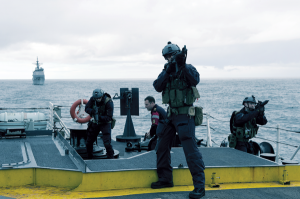Trident Fury
By Lookout on May 19, 2015 with Comments 0

The Naval Boarding Party from HMCS Winnipeg practices ship clearing drills during Exercise Trident Fury off the west coast of Vancouver Island on May 5.
Exercise Trident Fury ended last Friday with more than 1,200 personnel going back to their units with a strong sense of accomplishment having flexed their mettle / metal.
The warfare exercise, that took months of preparation for 12 days of round-the-clock training, is a biennial, and often multinational naval exercise held off the coast of Vancouver Island by Maritime Forces Pacific.
From May 4 to 15, seven Canadian and American naval vessels conducted maritime scenarios and weapons firing off in the Strait of Juan de Fuca. This location provided some challenges because to the south are active shipping lanes, but safety was at the forefront of the exercise.
Challenges and mounting complexity were built into each scenario by the planners.
Under assessment were air and surface joint operations that included maritime surveillance, live air and surface weapons firing, and anti-submarine warfare training.
Several government agencies were brought into the exercise.
Members of the Royal Canadian Mounted Police, the United States Navy (USN) and the United States Coast Guard (USCG) all brought their particular skill sets.
Over the course of the exercise these agencies enhanced their skills required to operate seamlessly with the military during real-life international operations.
Special guest Jason Kenney, Minister of National Defence and Minister for Multiculturalism, joined HMCS Winnipeg during the exercise to witness the full scope of Canada’s navy and air force capabilities.
Also participating in Trident Fury were HMCS Ships Calgary, Saskatoon, and Yellowknife, United States Ship Cape St. George, United States Coast Guard Cutter Active, and RCN Orca-class vessel Wolf.
Royal Canadian Air Force assets included the CP-140 Aurora Long Range Patrol Aircraft and CH-124 Sea King ship-based helicopters.
American air assets included the USN P-3 Orion Maritime Patrol aircraft, SH-60 Seahawk helicopters and EA-18 Growler electronic warfare jets.
Of particular interest, recent graduates of the first Maritime Tactical Operators Course who will form the Enhanced Naval Boarding Party (ENBP) Team 1 were woven into the exercise.
Although traditional Naval Boarding Parties are able to perform basic obstructed boardings, feedback from recent operational deployments, such as Operation Artemis, emphasized the need for a naval boarding party capable of meeting a new level of threat.
The ENBP was attached to Winnipeg, which gave the navy the opportunity to evaluate how the team operates and integrates with a ship’s company.
They practiced short notice opposed boardings, where a target vessel is resisting boarding attempts with deadly force.
“It was very impressive to see the tactical perspective they brought to the table, and how much they expanded the spectrum of our operations; nothing seemed beyond their capabilities,” said SLt Michael Buss, a bridge watch keeper in Winnipeg.
The enhanced portion of the new boarding party includes protection for ships as they transit through more precarious environments such the Strait of Hormuz.
The boarding party can also be employed as an assault team for VIP extractions ashore.
Over the two week period, ships, aircraft and personnel conducted 10 boarding serials, 34 opposing force probe harass and attack missions, nine gunnery serials, three anti-submarine serials, two helicopter deck landing qualifications and one missile exercise.
“The RCN is the gifted generalist in terms of capability. This exercise played to that strength and all the ships and aircraft benefitted from the dynamic and challenging environment of Trident Fury 15,” said Lt(N) Matthew Arthur, a logistical planner for the exercise.
Training exercises with international allies provide a unique opportunity to help foster cooperative relationships that are critical to ensuring the safety of sea lanes and security on the world’s oceans.
The United States is Canada’s most important ally and defence partner.
Defence and security relations between the two countries are longstanding, well-entrenched, and highly successful.
Lt(N) Paul Trenholm
MARPAC PA Office
Filed Under: Top Stories
About the Author:





